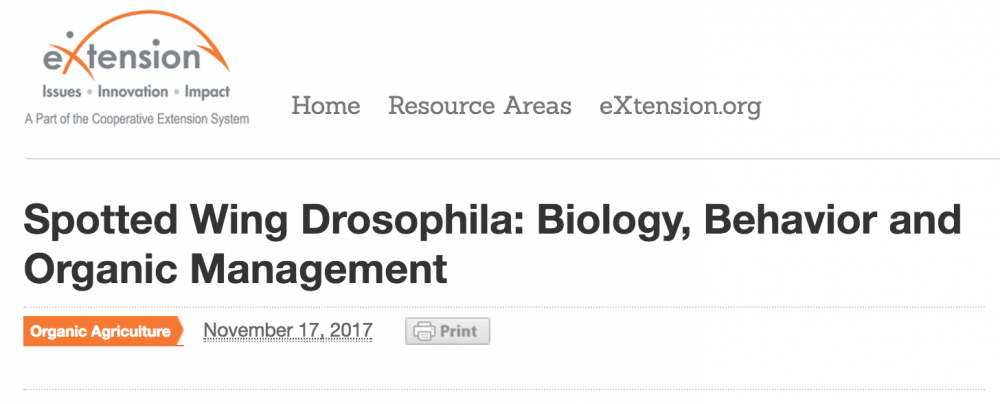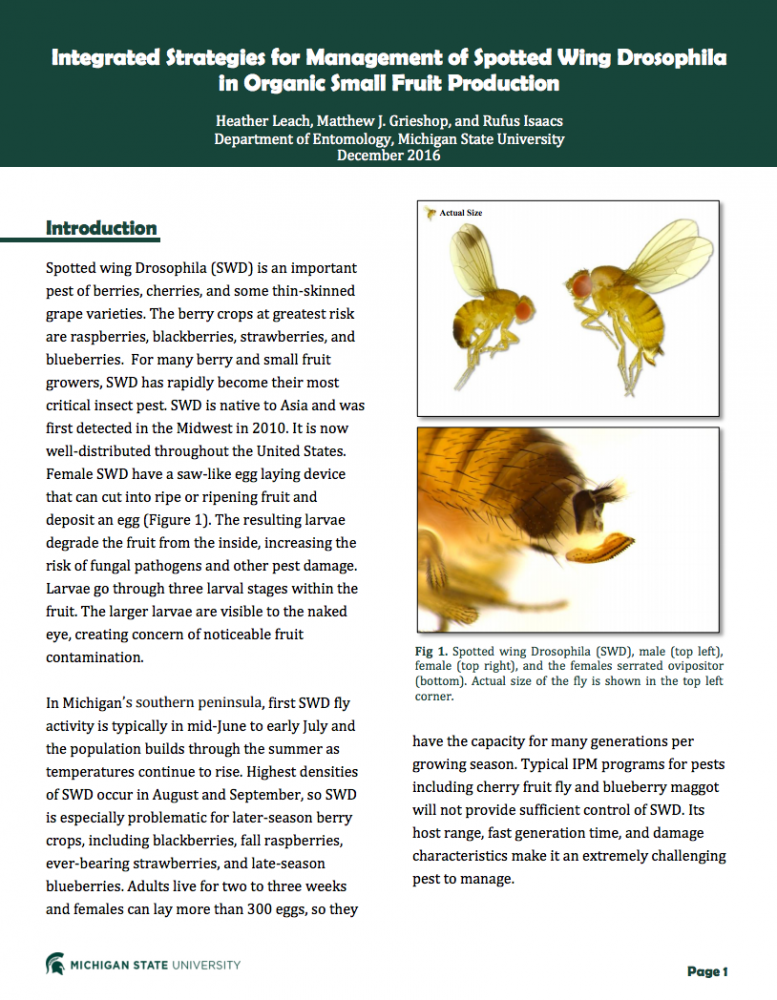Project Updates
OREI - Research and Extension Experience for Undergraduates (REEU) - 2023 & 2024
One of the objectives of the OREI grant is to develop an integrated outreach and education training programs to implement organic SWD management strategies. The result of this objective was the creation of a program where undergraduate students could create their own research projects. Our first REEU program occurred in the summer of 2023. We had 8 undergraduate participants and 8 mentors from institutions across the country. The program offered 4 workshops geared directly to the undergraduates, 4 workshops specifically for the mentors, and 9 different action learning workshops. At the end of the 13-week program, the undergraduate participants had the opportunity to present their research. More information on the participants can be found on the Participants page.
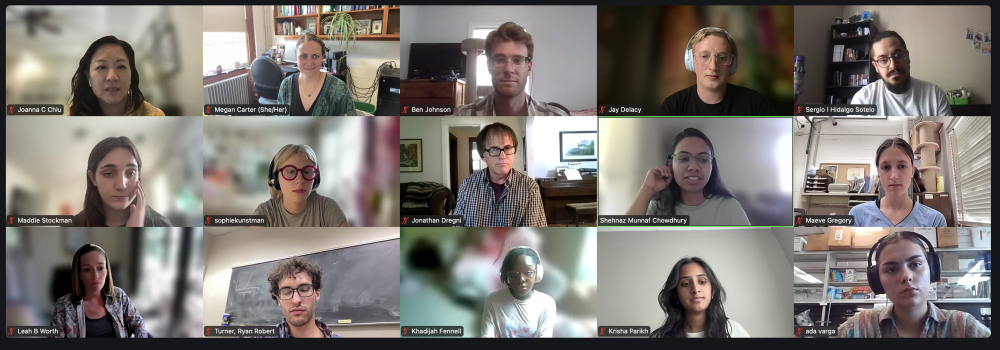
SWD Extension Publication
Now Available online - Nov 20, 2017
The Project Update page of the OREI SWD site has been a bit slow lately, but there is a good explanation. We have been hard at work creating an extension publication specifically about SWD biology and control. The publication is now available online on the eXtension webpage, here. Please read through this article, as it documents the most up-to-date options for organic SWD control, including 2017 field data from this project.
For more information about this publication, contact Dr. Andrew Petran, petra057@umn.edu.
List of Organic SWD Control Research
Now Available on Resources Page - May 23, 2017
The Resources page of this website has been updated to include a list of pertinent, organic SWD research that has been recently published. This list is not exhaustive, but meant to guide farmers and fellow researchers as they learn more about current knowledge of SWD biology, behavior and control practices. The list will be updated as more research gets released, so keep checking back!
Extension Bulletin for Organic SWD Management in Michigan
Now Available Online - March 7, 2017
One of the benefits of large, multi-University collaborations is that we can provide recommendations that are regionally specific. This is important for SWD, as best management practices may depend on environment. With one year of research, data collection and analysis behind us, our sites are starting to publish extension bulletins. This one comes out of Michigan State University, and details SWD biology along with recommendations on monitoring, cultivar selection, sanitation and exclusion, just to name a few!
For more information on this bulletin please contact Dr. Rufus Isaacs (isaacsr@umn.edu) or Dr. Phil Fanning (fanning9@msu.edu). We will post more regional bulletins as they become available, so check back soon!
Management of Spotted Wing Drosophila Webinar
Now Available Online - Feb 27, 2017
In early February, objective leads for the OREI project on spotted wing drosophila (SWD) held an informative webinar. This presentation documented an outline of the project, along with a summary of all analyzed data from the 2016 growing season. Projects and practices detailed in this webinar include attract and kill traps, organic spray efficacy trials and SWD exclusion with insect netting. Our webinar may be helpful for any grower seeking organic methods of controlling SWD, and can be found here. Please revisit this site as we keep you up to date with our preparations for the 2017 season.
Exclusion Research in Minnesota and Arkansas
Combined Results and analysis - Jan 10 2017
MN and AR conducted SWD exclusion trials during the 2016 season. The purpose of these trials were to determine the effectiveness of physical barriers for SWD control, and the ways in which exclusion tactics alter the growing microenvironment.
The 2 sites employed slightly different methodologies for implementing and measuring the effectiveness exclusion practices:
- MN grew fall-bearing raspberries under 3 treatments: plastic 'mini tunnels' with 80g insect netting capped on each end, plastic mini tunnels without insect netting, and open-field control. MN measured marketable/cull yields, % RH and % infestation of fruit in each treatment throughout the harvest season.
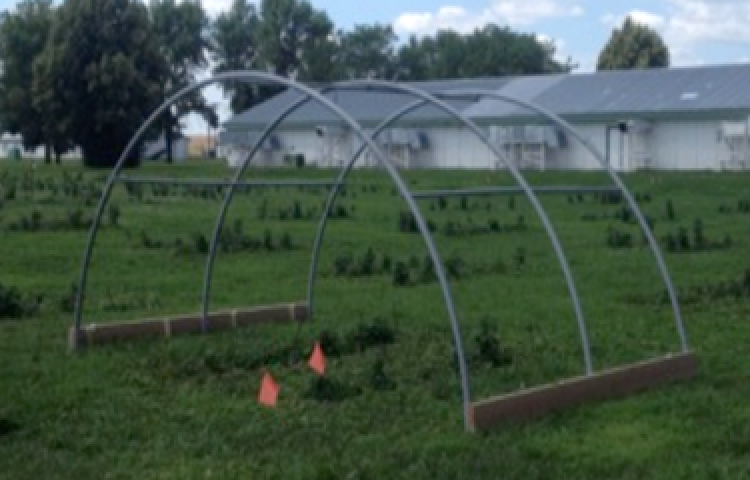
Skeleton of mini high tunnel in MN
- AR grew blackberries under 4 treatments: large high tunnel with netted ends, a mini tunnel completely wrapped in plastic, a mini tunnel completely wrapped in insect netting, and open-field control. AR measured temperature, adult trap capture and % infestation of fruit in each treatment throughout the harvest season.
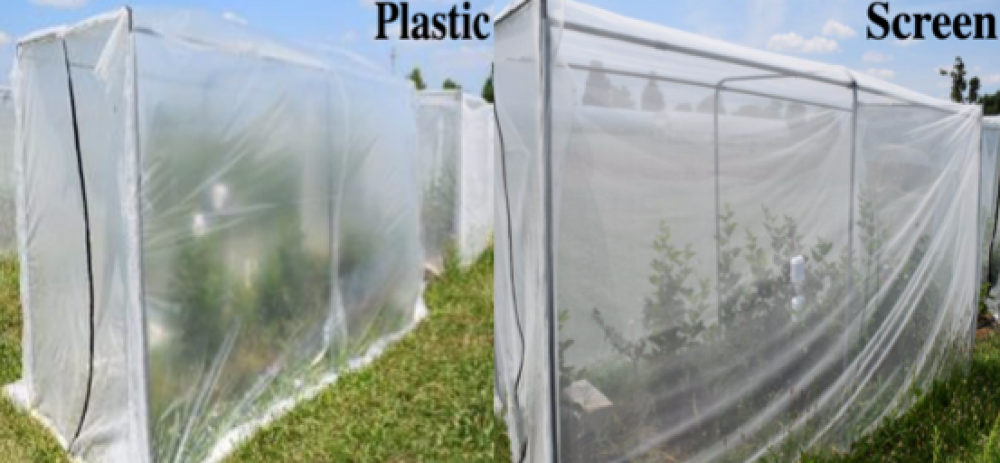
Mini high tunnel design in AR
Despite slightly different treatment and measurements, not to mention the considerably different locations, both sites observed similar results, namely that capping tunnels with insect netting reduces SWD presence within the tunnel, and that tunnel presence and type often influences microenvironment compared to open-field controls.
In AR, completely excluded treatments never experienced SWD infestation in their fruit (except for the mini tunnel with insect netting, after the door blew open during a storm), while open-field controls suffered varying infestation throughout the harvest season:
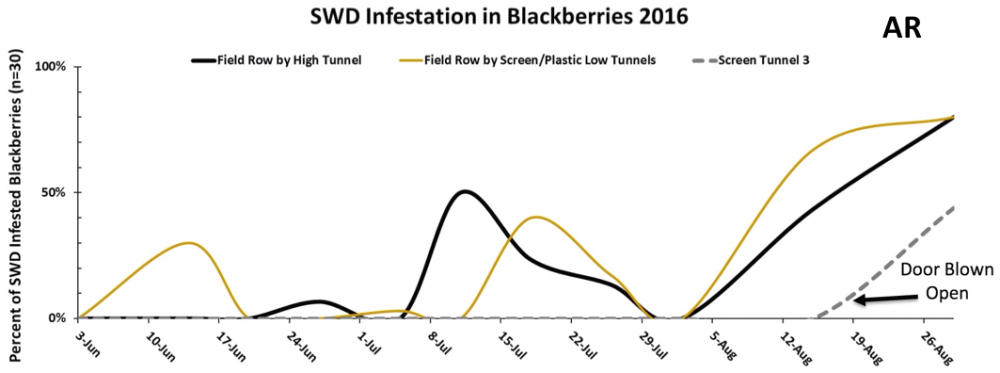
In MN, netting was capped on half of the mini tunnels halfway through the season to examine infestation in a tunnel microenvironment that already had natural infestation. Netted tunnels experienced reduced SWD infestation in fruit, even less than 1 week after tunnels were netted:
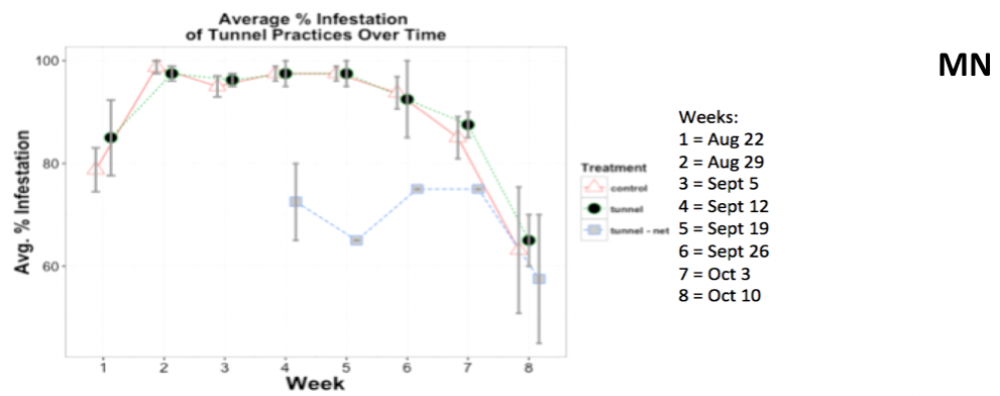
MN also observed that total marketable yields and marketable:cull ratios were greater in the netted mini tunnels, suggesting that physical exclusion not only reduces SWD infestation but produces high quality fruit relative to non-netted treatments where natural SWD is present.

This research, while only from 1 field season, demonstrates the promise that physical exclusion presents for reducing SWD infestation, organically and without the need for sprays. Economic analyses of these practices are a priority of objective 4 of this project; findings are forthcoming, so stay tuned!
Trapping Research in Wisconsin
Methods and Selected Results - November 9 2016
As we head towards the end of autumn, results from our first growing season can be compiled and summarized. The first such summary is from Wisconsin, detailed below.
The University of Wisconsin is contributing to Objective 1.1 which involves a multistate comparison of SWD attractants alone or in combination, and the impact of background odors on trapping SWD on raspberry, blueberry, and blackberry plants.
The attractants we tested were:
(A) Yeast and Sugar (YS)
(B) Yeast, Flour and Vinegar (YFV)
(C) Commercial Scentry Lure (SC)
(D) Raspberry chemical lure (RC)
(E) Yeast and Sugar + Commercial Scentry Lure (YS + SC)
(F) Yeast, Flour and Vinegar + Commercial Scentry Lure (YFV + SC)
(G) Yeast and Sugar + Raspberry chemical lure (YS + RC)
(H) Yeast, Flour and Vinegar + Raspberry chemical lure (YFV + RC)
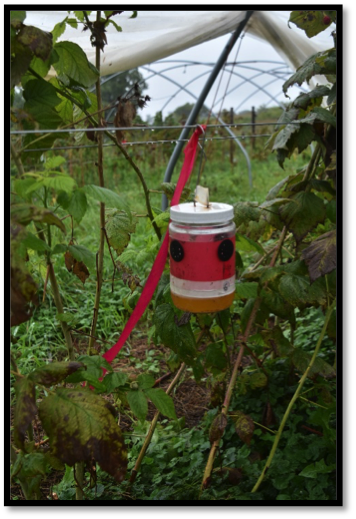
SWD Trap in Wisconsin
This study is being tested across five states and with several different crops, using the same methods and testing the same lures and baits.
Here we present data for Wisconsin and will later present the data for all states combined. In Wisconsin, we are using an organic raspberry farm located outside of La Crosse, WI. The experiment was completed over two four week blocks; one in early June and the other starting mid-August. These time periods were chosen to overlap with the beginning of the summer raspberry harvest (June) and peak SWD activity (August). Traps were serviced weekly and trap catches brought back to the lab, where the number of SWD males and females and non-target drosophilids were recorded.
In Wisconsin, we trapped the most SWD using a yeast and sugar trap, even more than when we added a commercial lure (Figure 1; Table 1). Even though this difference was not statistically significant, it suggests that odors associated with fermenting fruit (yeast and sugar) are very attractive to SWD.
For more questions or information about the work being done in Wisconsin, please contact Dr. Christelle Guédot (guedot@wisc.edu) or Dr. Benjamin Jaffe (bjaffe2@wisc.edu).

Figure 1: Average spotted wing drosophila (SWD) trapped per week by attractant type. Treatments with the same letter above them are not significantly different (P < 0.05).
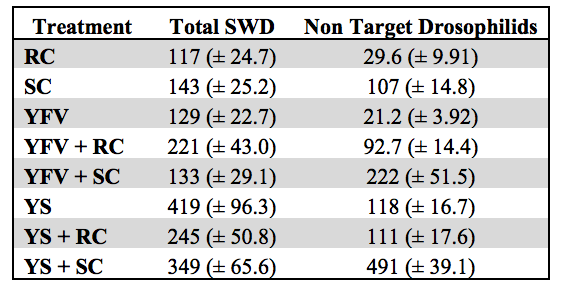
Table 1: Average (± standard error) spotted wing drosophila (SWD) and non-target drosophilds trapped per week by attractant type.
East Coast Updates
Pertinent Info for Growers in the Mid-Atlantic - October 28, 2016
Two of the collaborators on this SWD project, Hannah Burrack & Lauren Diepenbrock, have been hard at work blogging grower-friendly info for farmers at NCSU. This work includes weekly trap count updates, how to calibrate sprayers for use against SWD, and a summary of SWD infestation in blackberry canes in the region.
Congrats to Hannah and Lauren for their great work, and stay tuned for summaries of research throughout the country as the field season wraps up.
Spray Trial in Minnesota
Methods & Purpose - August 24, 2016
One of the trials pursuing objective 3 (found in the about section of this website) of this project deals with the efficacy of organically approved insecticides at controlling SWD. In Minnesota we are performing a semi-field bioassay spray trial, meaning that the trial contains both field and laboratory components.
Our field plot is in Hastings, MN, where we have begun spraying fall-bearing raspberry plants. There are 4 spray treatments:
- Entrust
- Grandevo
- Azera
- Control (water)
Each treatment has 5 replicates arranged randomly in blocks across the 4 rows of raspberries. One difference between fruit production and fruit research is that research heavily incorporates replication and randomization into its experimental design in an attempt to reduce error. An outline of the experimental design is shown below.
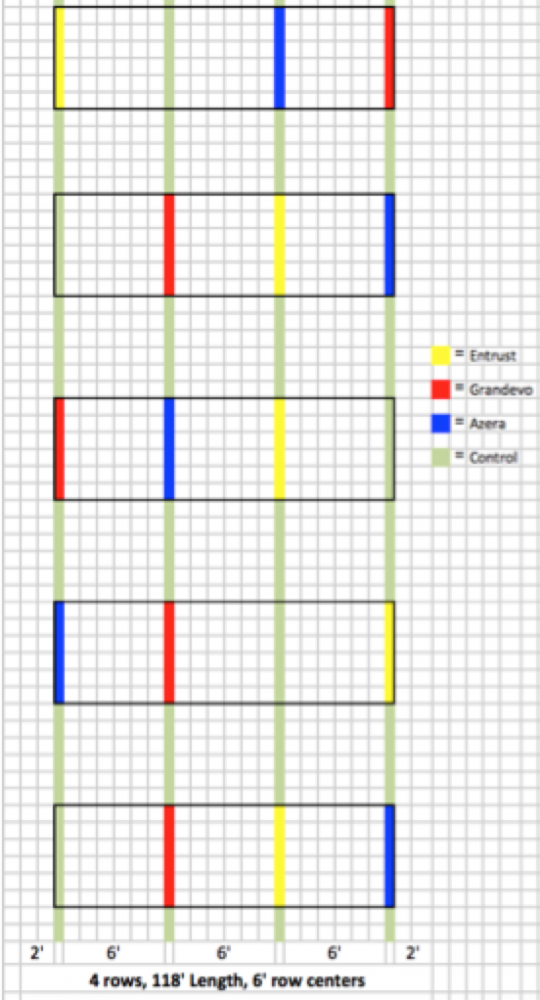
After spraying the treatments, vegetative cuttings are removed at 0, 3, 5 and 7 days after treatment, placed into labeled chambers and brought back to the lab. The chambers are then infested with SWD. Mortality is recorded at 1, 3 and 5 days after chamber infestation.
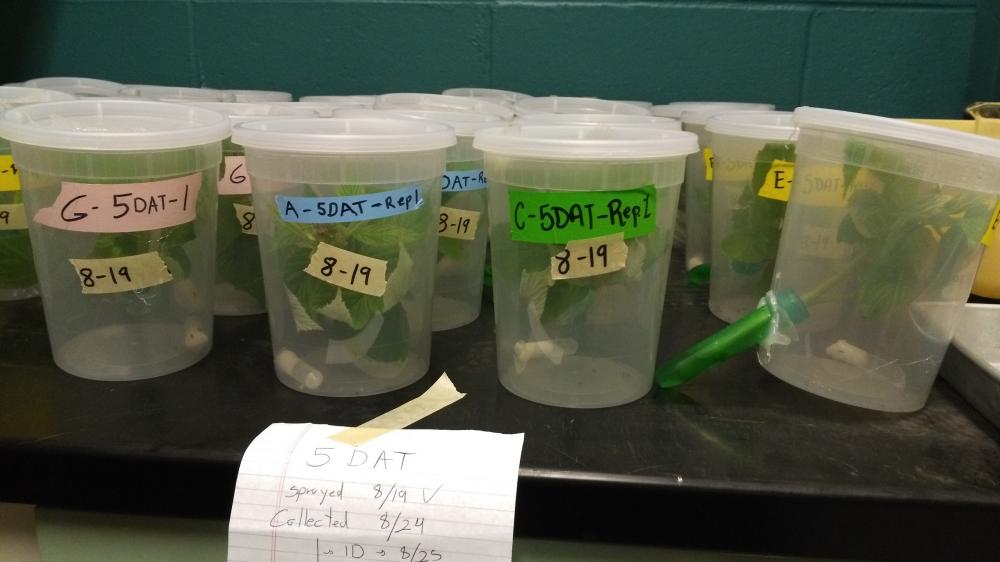
Spraying is done once a week, for 4 weeks. After all the mortality data has been taken, it will allow us to determine if there are differences in SWD control efficacy among the 4 treatments, and if certain treatments remain effective on the plants longer than others. Eventually we hope to be able to make recommendations to growers who wish to incorporate organic sprays into their SWD IPM practices. For more information on this project in Minnesota, please contact Dr. Mary Rogers (roge0168@umn.edu) or Dr. Andrew Petran (petra057@umn.edu).
Mulching Study in Minnesota
Protecting Infested Fruit - July 29, 2016
Conducting field research can prove troublesome due to the sheer number of factors that exist in the environment. As scientists we attempt to reduce unwanted variables as much as possible, so field research can present unique challenges. Hailstorms, tornadoes or predators can disrupt even the best laid out methodologies.
Such an event occured in Winona, MN in mid-July. This site was performing a mulching analysis similar to the described in our June 22 post from Maryland. Berries are artificially infested with SWD, separated by eggs laid per berry, and placed evenly into tightly woven, fine mesh bags to be placed into different mulching treatments in the field. The bags remain in the field for 7 days, unopened, until they are retrieved and brought back to the lab for analysis of SWD development or adult emergence. The idea is to identify possible mulching treatments that reduce the development of infested fruit that has fallen from the plant. While this method has worked perfectly well in other sites, the bags fell prey to hungry animals in Winona.
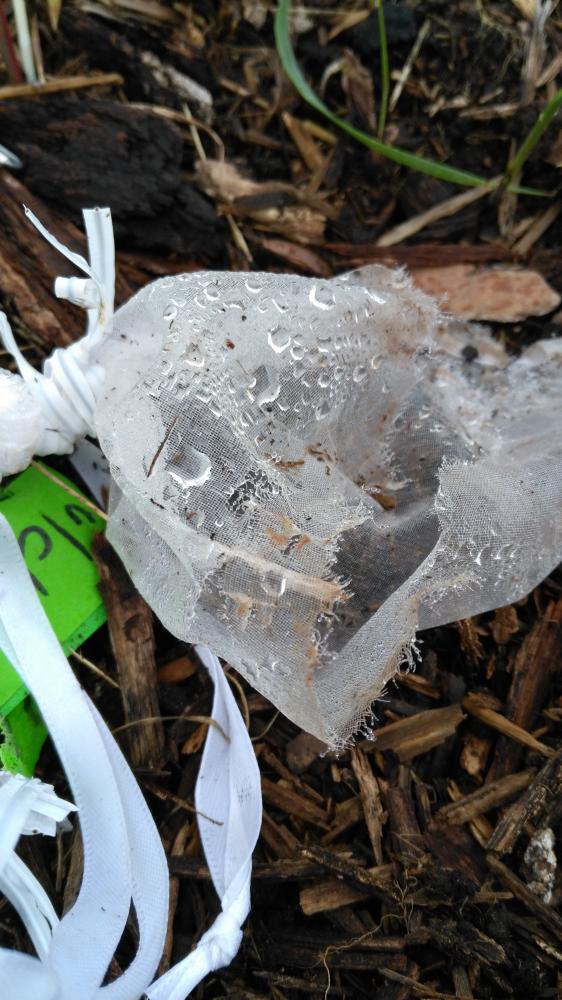
Our farmer collaborator believes it may have been skunks or raccoons, but either way about 2 weeks of finely developed research was lost to the environment. Fortunately MN still has time and supplies to redo the experiment, except this time the methods will be altered to provide more protection to the fruit.
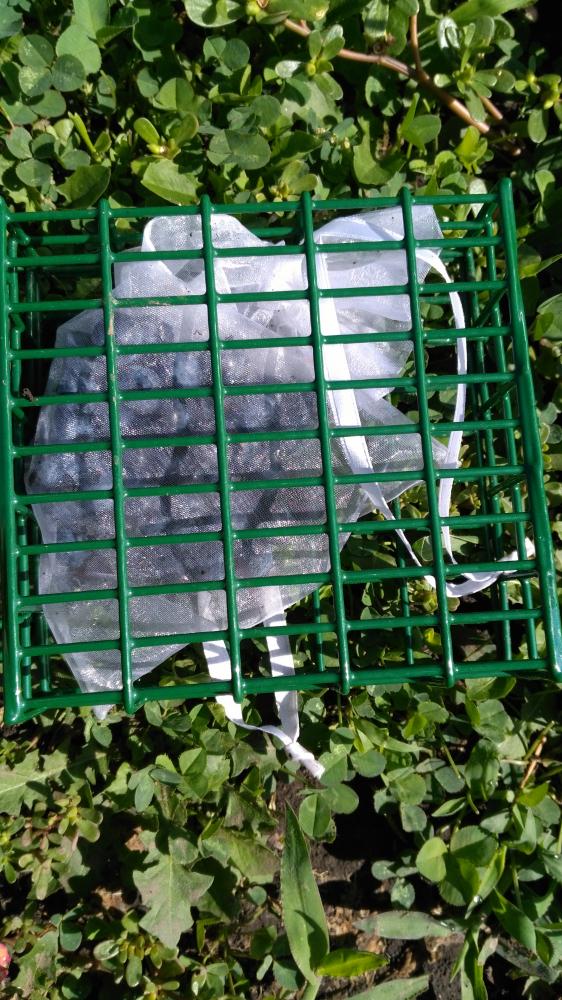
These cages will ideally keep mammals from further disrupting the experiment without altering the microenvironment around the fruit. If successful MN can continue contributing to objective 3, the development of cultural practices that reduce SWD pressure. For more information on MN projects contact Dr. Mary Rogers (roge0168@umn.edu) or Dr. Andrew Petran (petra057@umn.edu).
Low Tunnel Exclusion Study in Arkansas
Tunnel Construction - initial work: June 28, 2016
Methodology Overview
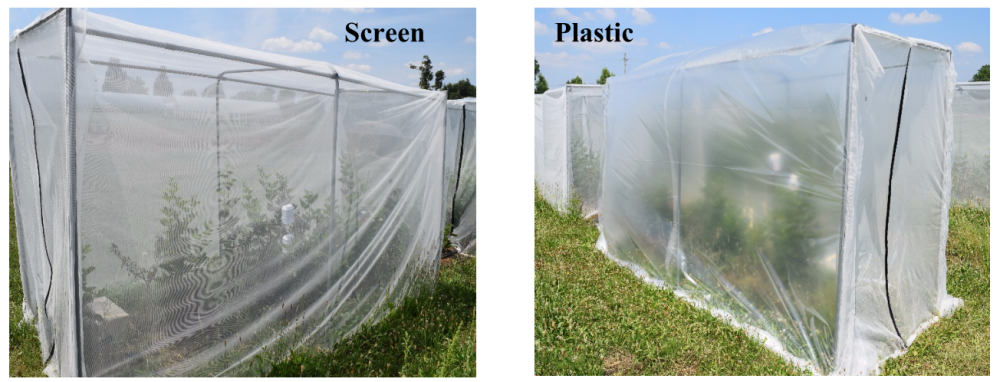
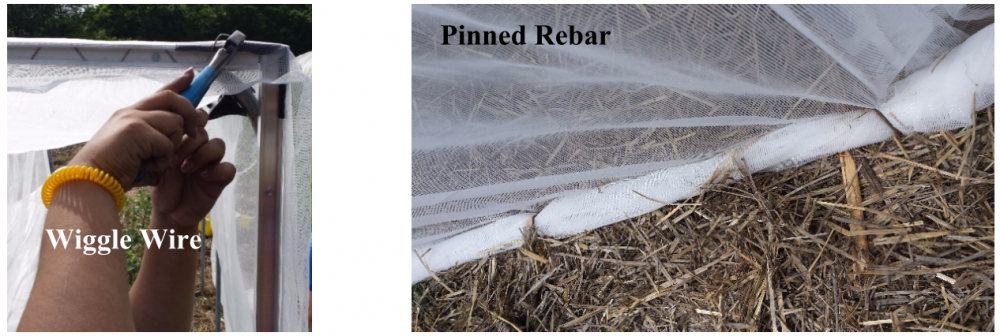
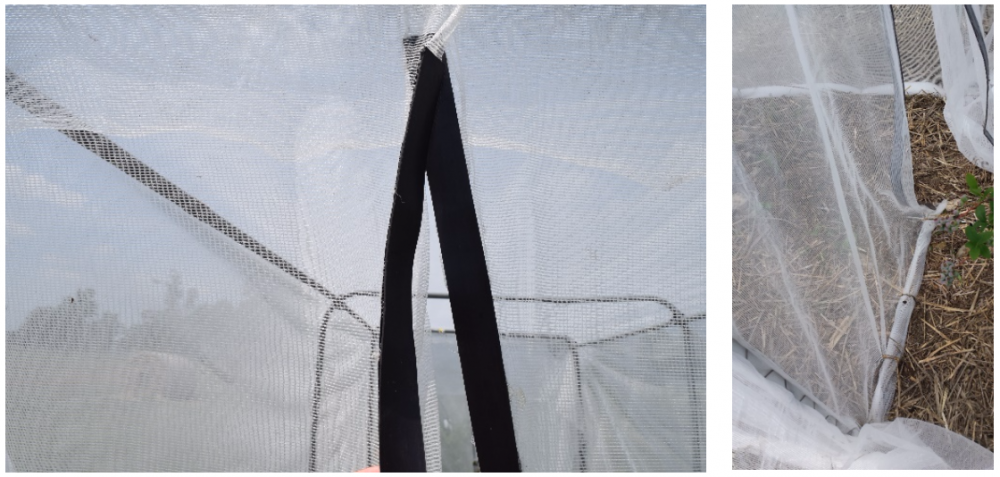
Mulching and Pruning Studies in MD
June 22 2016
Methodology Overview
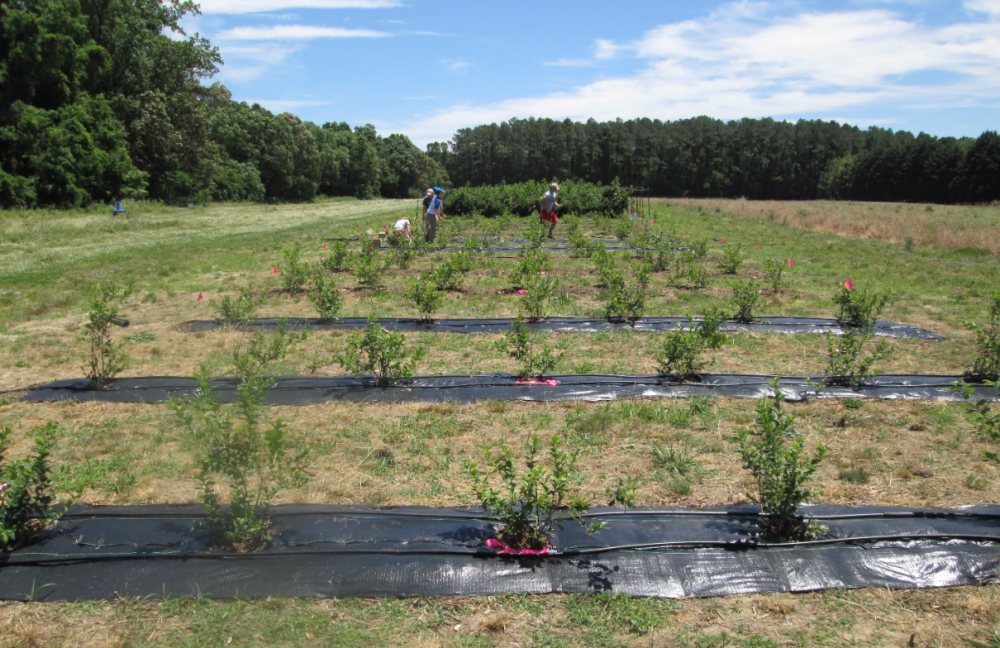
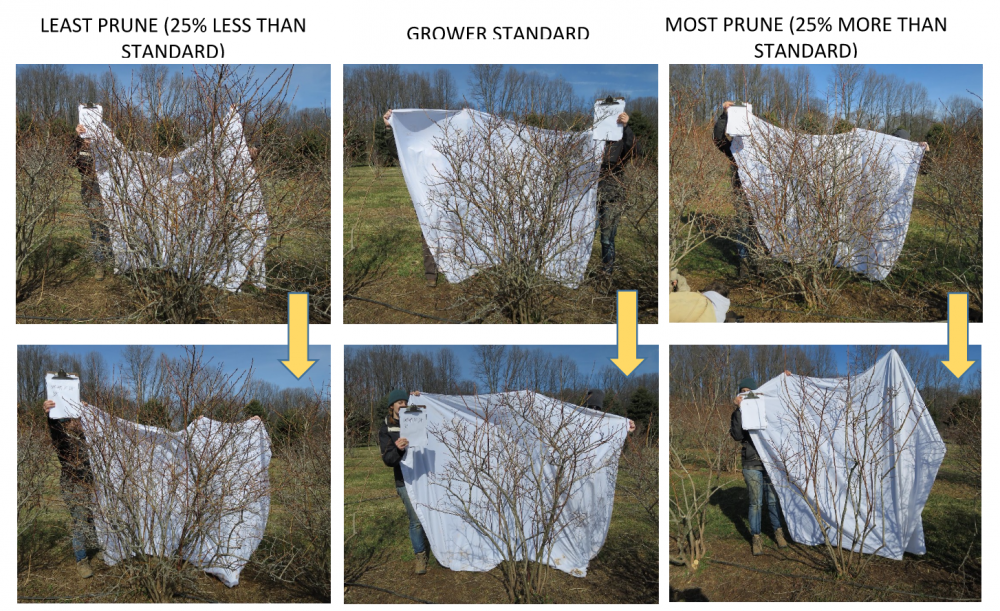
How to Track SWD Progress in the Eastern US
Other online resources - June 16, 2016
Many of the University collaborators on this project have resources other than this website for growers to obtain SWD related information. Several contribute to the Eastern Spotted Wing Drosophila Volunteer Monitoring Network, and present their data on the Early Detection and Distribution Mapping System website. Growers in the eastern US can use this site to help determine if SWD has been detected in their region.
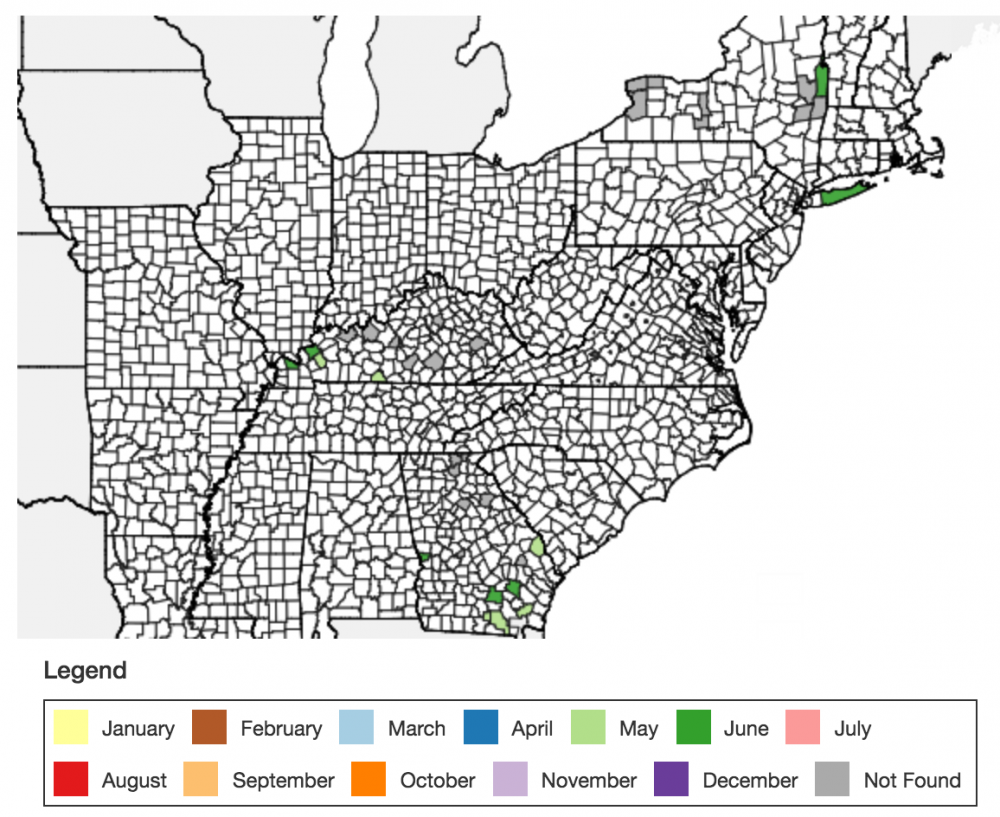
In addition, the NCSU Cooperative Extension webpage features weekly SWD updates of their site research, including trapping data and methodology overviews. Visit these sites and others to learn more about SWD control and management!
Blueberry Weed Mats & Irrigation
Floor management - initial work, May 19 2016
Methodology Overview - OR site
One project to accomplish objective 2 (discussed in our about page) investigates how weed mats and irrigation systems (two aspects of fruit floor management) affect the survival of SWD larvae and pupae on the soil. Oregon is one of the many states collaborating on this project, and their site is featured in this post.
We have established two floor management treatments:
1) A black weed mat, over standard grower sawdust mulch.
2) A standard grower sawdust mulch without a weed mat.
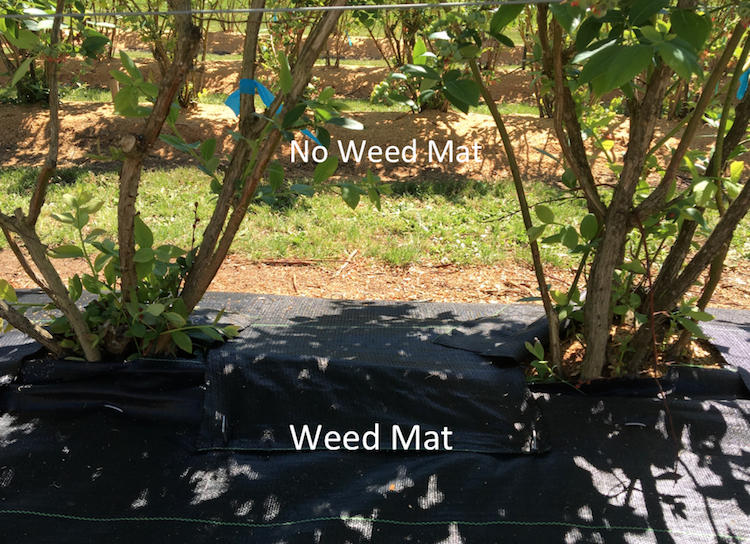
For rows with no weed mat, we are also looking at two irrigation systems: drip and overhead sprinkler.
For each irrigation/weed mat treatment, we are deploying bags of blueberries infested with SWD larvae on top of the soil and underneath the soil for one week in the fields, and then count how many adult flies emerge (survival) from each bag.
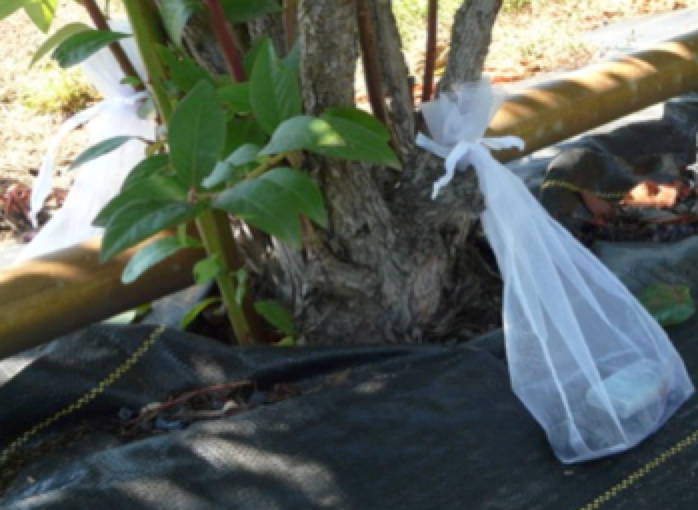
Testing will be done with infested fruit (survival inside fruit) and pre-pupae outside the fruit. Additionally, we are collecting data on temperature and humidity above and below the mulch, to determine how the presence of the weed mat and irrigation system affects the microclimate, and in turn, SWD pupae survival.
With this data we hope to make recommendations to growers about which floor management techniques are least conducive to SWD. For questions or more information about the OR site, please contact Dalila Rendon (dalila.rendon@oregonstate.edu), Daniel Dalton (daniel.dalton@oregonstate.edu), or Vaughn Walton (vaugh.walton@oregonstate.edu).
Blueberry Pruning Objective
Canopy management - Initial work, May 4 2016
Methodology Overview - MN site
The SWD project is comprehensive. It perhaps is best considered as a 4-pronged approach to study, understand and ultimately control SWD using organic practices throughout the United States. Each prong is an objective (which you can learn in the about section of this site) with specific projects designed to fulfill that objective. One project to help fulfill objective 3 deals with canopy management, or the effects of pruning practices on SWD. We are contributing to this project here at the MN site, collaborating with a farmer cooperator in Northfield, MN. So far we have established 3 different pruning treatments:
1) A grower standard pruning practice.
2) A light prune, relative to the grower standard.
3) A heavy prune relative to the grower standard.
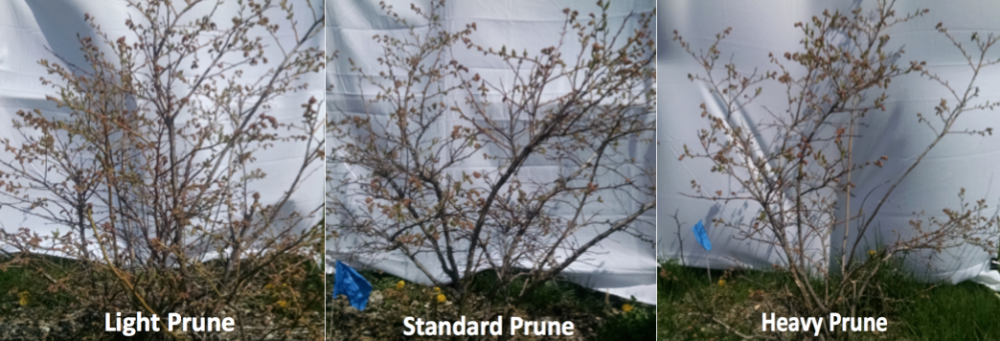
Once the season progresses and the plants begin to produce fruit, we will begin taking data. Our primary objective is to examine if there are any differences in ambient temperature, berry temperature, relative humidity, SWD infestation or yield among our three pruning treatments. If differences are observed it will allow us to make better pruning recommendations to growers in our region.
Extension bulletins customized by national regions will be published based off this and our many other projects as data starts flowing in, so stay tuned! For more information or questions about this project, contact Andrew Petran petra057@umn.edu
Funding

Funding for this website is from the USDA NIFA Organic Research and Extension Initiative (OREI) Program. Grant numbers: 2022-51300-37890, 2018-51300-28434 and 2015-51300-24154.

